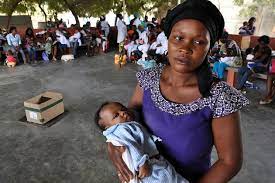Angola’s fertility rate is 6.2 live births per woman, while the maternal death rate, or maternal mortality ratio (MMR), stands at 239 deaths per 100,000 live birth”It is very gratifying to be able to accompany a pregnant woman from her first consultation until delivery,” says Leonor Teles Daniel, a nurse at Namacunde municipal hospital in Cunene, one of Angola’s drought-affected province.
Responsible for the delivery room, she is proud to belong to a profession that cares for pregnant women.
Olga Dos Santos, a nurse at Humpata municipal hospital in Huila province, is equally passionate about her work, yet she faces greater difficulties than her nursing colleagues in other provinces due to disparities in health outcomes in the country’s geographic locations.
In the oil and water-rich province of Cabinda, 82 percent of births take place in hospital units, according to data from the Multiple Indicator and Health Survey (IIMS, 2015-2016).
This number drops in regions with drought, such as Huila province, where just 30 per cent of births occur in health units, and Cunene province, where the figure is even lower at 26 per cent – just one in four.
The second largest country in sub-Saharan Africa, Angola is vast and diverse in terms of geography and culture.
The nation’s population stands at an estimated 36 million, of which about two thirds (64 per cent) are under the age of 25, according to the UN Population Division (2022).
With a population growth rate of 3 per cent, the population is expected to reach 45 million by 2030.
The country’s fertility rate is 6.2 live births per woman, while the maternal death rate, or maternal mortality ratio (MMR), stands at 239 deaths per 100,000 live births.
The underlying causes for maternal mortality are the three classic delays: in taking the decision to seek health services, in reaching the health centre, and in receiving adequate obstetric and neonatal care at the health centre.
Many pregnant women making these decisions are in fact girls, as more than a third (35 per cent) of girls aged 15 to 19 years have been pregnant.
Many of them struggle to access contraception information, products and services.
Technology and training to improve care and incentivise births in hospitals
Interventions that improve the quality of health services, the perception of health care and health service conditions are key incentives for women to attend prenatal consultations and their deliver babies at health units.
The Ministry of Health of Angola (MINSA) launched systems strengthening and human resource improvement interventions through the Programa de Fortalecimento do Sistema de Saúde (Programme to Strengthen Health Systems.)
Ms. Daniel and Ms. Dos Santos are part of a group of 240 health professionals being trained through PFSS, which partners with UNFPA and the World Bank, to strengthen sexual and reproductive health services in the drought-affected provinces of Cunene, Namibe, Huila and Cuando Cubango.
This programme trains health professionals in obstetric and neonatal emergencies, using new technological tools to improve the quality of health care.
Additionally, health technicians have received training to respond to young people and adolescents in specific units.
The aim is to strengthen the health system and ensure quality of care, so that births and consultations take place in hospitals, improving maternal health outcomes.
“Before, we worked without rules. Since the training, I have learnt how to deal with pregnant women correctly,” says Nurse Daniel. One of her goals is to get pregnant women to understand the importance of attending all their prenatal consultations, and visiting health centres if they have any concerns or feel anything strange during their pregnancies.
In a province more than 10 thousand kilometres away, Nurse Dos Santos expresses her concern that communication between health workers and patients needs improvement. Where she works, many patients speak a local language, an additional challenge for the health workers.
As part of the initiative to strengthen health workers’ response, the Government of Angola, in partnership with UNFPA and the Maternity Foundation, launched a Portuguese version of the Safe Delivery App to help nurses and midwives providing obstetric care.
The introduction of the app in southern Angola is part of MINSA’s programme of priority actions in the four provinces to lessen the effects of the drought.
Ms. Dos Santos and Ms. Daniel attended the virtual training sessions and have been using the app since.
It includes videos and audios, and gives health practitioners concrete information and steps to respond to all potential maternal health scenarios, especially in response to complications that arise.
“Before the application, there was a bit of a disparity. We used to transfer all the cases that arose to the central maternity hospital. Today, we apply the knowledge we have learned with the help of the application, and only then do we transfer them to Irene Neto Maternity Hospital,” says Ms. Dos Santos.
With the launch of the app, community agents and midwives in rural areas are to be trained to help women overcome barriers due to local dialects and language in general, so they feel safe reaching out to their nearest health units. With the institutionalization of deliveries, it is expected that the Safe Delivery App will support more than 50,000 births in Cunene province, and more than 54,000 in Huila province.
The Ministry of Health’s Health System Strengthening Project (PFSS) is working to improve quality of care and ensure that deliveries and consultations take place in hospital units.




